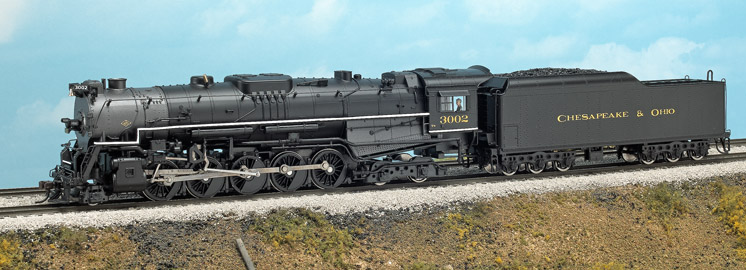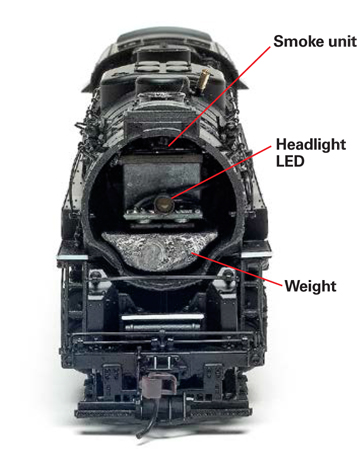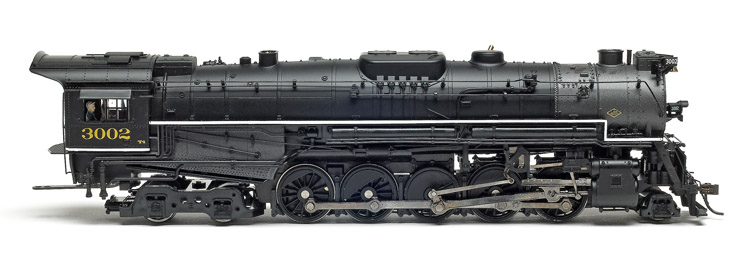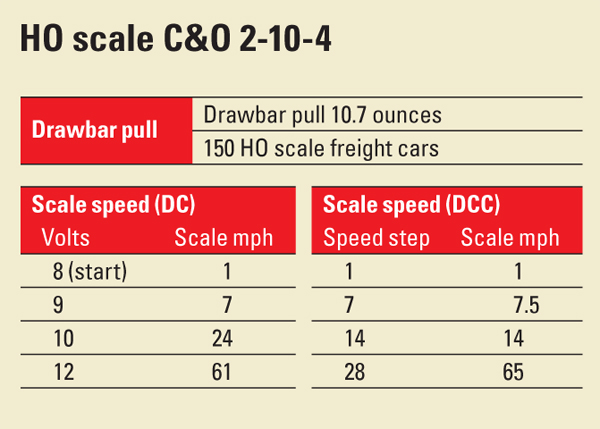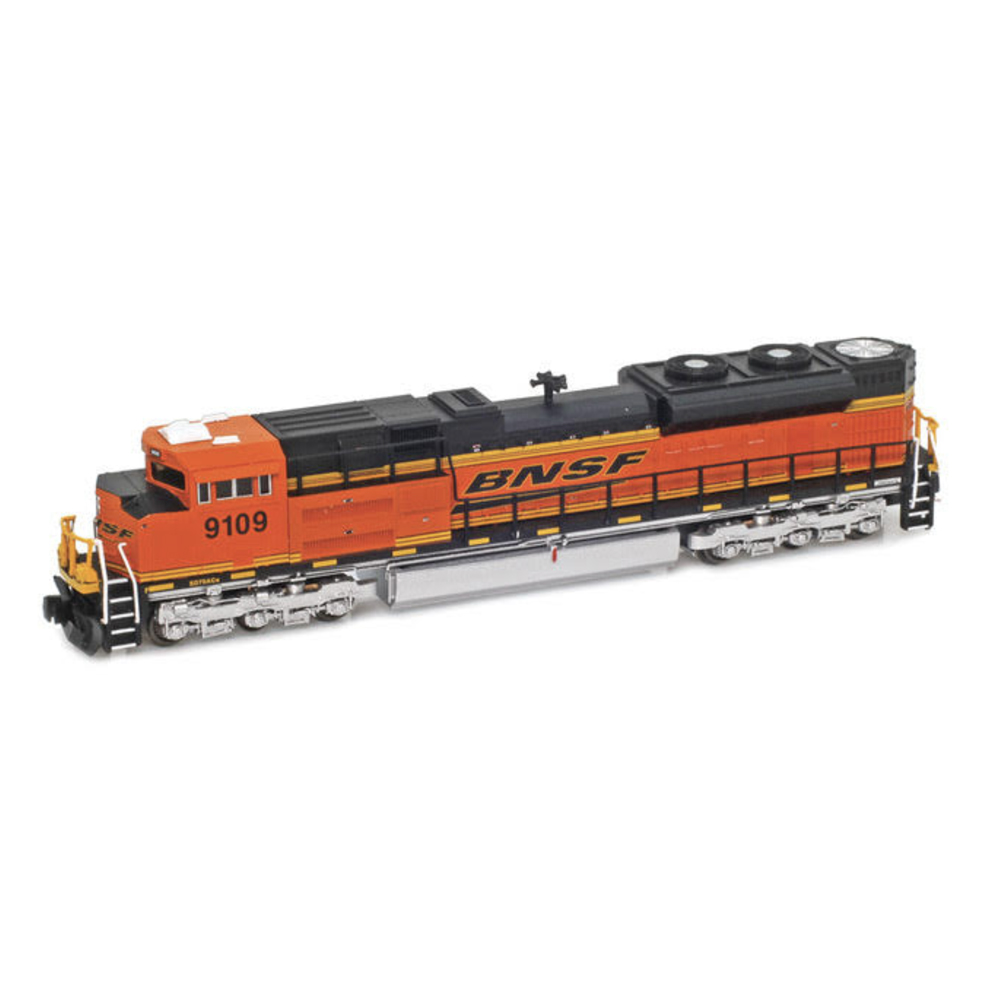Broadway Limited’s HO scale T-1 is a handsome brute, accurately reproducing one of the most powerful two-cylinder steam locomotives ever built. The model features finely molded boiler detail and wire grab irons, and is equipped with a dual-mode Paragon2 Digital Command Control sound decoder and smoke unit.
In search of power. In 1929, the C&O wanted to develop a single locomotive that could pull long coal trains by itself from Russell, W.Va., all the way to Lake Erie. Railroad officials ran some tests with a Lima-built Erie 2-8-4 Berkshire, but it came up short in pulling power.
So the C&O designed a larger version of the Berkshire, adding a driver axle, enlarging the boiler and firebox, and increasing the drivers to 69″ diameter. Lima Locomotive Works built 40 of the new 2-10-4s for the C&O between August and November 1930.
Before long, the T-1s were hauling 160-car coal drags across Ohio almost unassisted – a job they did for nearly 20 years. They were replaced by Electro-Motive Division F7 diesels in April 1952 and scrapped by July 1953.
The body is painted an even, smooth satin black, and the smokebox is graphite. The yellow cab lettering is crisp and opaque. The tiny lettering in the builder’s plates on either side of the smokebox is clear and legible. The driver faces are painted black, while their treads, like the other wheels, are chemically blackened.
The middle set of drivers is blind, or flangeless, to allow the model to handle 22″ radius curves. Though this was typically also true of prototype ten-coupled steam locomotives, it wasn’t on the C&O’s class T-1; instead, lateral play was designed into the driver axles and running gear to allow them to shift along curves.
The engine’s two-wheel pilot and four-wheel trailing trucks are sprung to help them track on sharp curves and uneven trackwork. I ran the 2-10-4 through the no. 5 turnouts of our Wisconsin & Southern project layout without any trouble.
On our DC test track, the sound decoder started up at 7 volts, typical for a sound decoder-equipped locomotive model. Though the voltage requirements of sound decoders limit the usable voltage range of a decoder-equipped locomotive in DC, BLI’s T-1 is geared for smooth slow-speed performance. At 8V, the engine started moving steadily at an impressively slow 1 scale mph. It topped out at 61 scale mph at 12V, an
appropriate top speed for its prototype.
The model’s drawbar pull was also impressive, the product of traction tires on the rear axle of a nearly 11⁄2-pound engine. Our test bench’s force meter registered a drawbar pull of 10.7 ounces, or 2⁄3 of a pound. Based on our measure of 14 standard 40-foot HO scale boxcars per ounce, we judged that the HO model could pull about 150 free-rolling cars on straight and level track.
Broadway Limited Imports offers the DC Master, a device that connects between a direct-current power pack and the layout. It has four buttons that give a DC operator access to some of the functions of a BLI Blue Line or Paragon2 decoder. I used one to activate the bell, whistle, and air compressor sounds, as well as to adjust the sound volume.
Speaking of sounds, those produced by the dual downward-facing speakers in the tender were robust and realistic. Under DC control, steam chuffs sounded automatically, synchronized to driver rotation. Slowing the engine suddenly resulted in a brake squeal. The clank of a Johnson bar sounded when the direction was reversed. Other automatic sounds played randomly.
More sounds were available under DCC. Using the function keys on our NCE Power Cab, I triggered the bell, coupler crash, air compressor, and a realistic, powerful whistle. The decoder’s sound menu also includes ambient noises and radio cab chatter.
The engine’s performance under DCC was as smooth and powerful as under DC. The locomotive started out at 1 scale mph at speed step 1, and topped out at 65 scale mph at speed step 28. Switching the DCC system over to 128 speed steps offered finer slow-speed control.
Finally, I added a few drops of the supplied smoke fluid to the smokestack and flipped the slide switch to turn on the smoke generator. After a brief wait, smoke began to wisp from the stack.
Broadway Limited’s C&O class T-1 is a stellar performer. It’s a handsome, well-detailed model that can more than pull its weight on an HO scale layout.
Manufacturer
Broadway Limited Imports LLC
9 East Tower Circle
Ormond Beach, FL 32174
www.broadway-limited.com
Era: 1930 to 1953
Road numbers: 3002, 3009, 3014, 3020, and 3024, plus painted but unlettered
Features
- All drivers powered; center set blind (flangeless)
- Blackened metal wheels, in gauge
- Crew figures in cab
- Electrical pickup on first four driver axles and first, third, fourth, and sixth tender axles Five-pole, skew-wound can motor with flywheel
- Golden-white light-emitting diode headlight and backup light
- Kadee-compatible metal knuckle couplers, at correct height
- Minimum radius: 22″
- Separately applied turned-brass pop valves, whistle, and bell
- Smoke generator synchronized to steam chuffs
- Traction tires on rear driver axle
- Weight: 1 lb. 15 oz. (with tender; engine only, 1 lb. 6 oz.)
- Wire hand grabs





